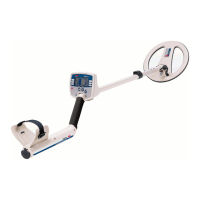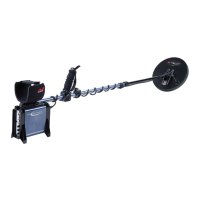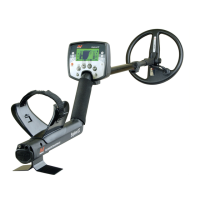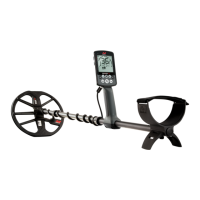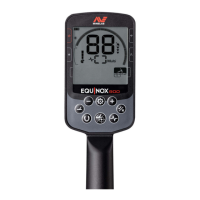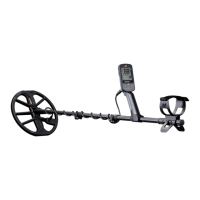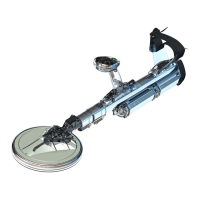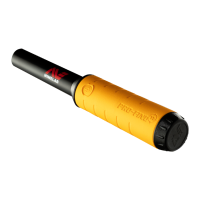Expert Menu
Trash Density
Range: Low or High
Factory Preset: Low
The Trash Density setting will enable you to
optimise the Discrimination of the detector
for areas that have highly variable ground
mineralisation or unusually high amounts of
ferrous objects.
When the Discrimination Pattern is ‘All Metal’,
the Trash Density setting has no effect.
When the Discrimination Pattern has rejected
(black) areas E-Trac will produce different
detection results depending on the Trash
Density setting. The Trash Density setting will
not affect the target audio response
Low is recommended in areas that have low
ground mineralisation or low amounts of
ferrous trash.
High is recommend in areas with highly
variable ground mineralisation or unusually
high amounts of ferrous objects (Iron trash).
Low
In Low setting, E-Trac locks onto the strongest
signal target during detection and the
detector displays the most stable Target ID.
For example, when a coin is buried amongst
nails and you are using a Disc. Pattern that
accepts coins and rejects nails, the detector
will lock onto the target with the strongest
signal. If the coin produces a stronger signal
response, then the Target ID for the coin will
be displayed at the end of detection.
Trash Density Performance Characteristics
Setting Accept/Reject
Functionality
Detection in average
soils, and low trash sites
Detection in mineralised
soils, and high trash sites
Trash Density
Low Very good Very good Average – may miss
detection of nonferrous
targets
High
Average Very good Good
It is recommended to use Low in areas with
low trash. It is not recommended to use Low
in areas where a “good” target may be masked
by the presence of strong signals from ferrous
objects or high ground mineralisation.
The Low Trash Density setting also allows
you to create a quite narrow discrimination
pattern for a specific target as the Target ID is
more stable than in High Trash Density.
High
In High setting, E-Trac searches for the best
accepted target signal during detection
and then displays the most stable Target
ID. The High setting allows you to detect
the accepted targets in the presence of
ferrous objects or high ground mineralisation
amongst a number of rejected targets.
For example, when a coin is buried amongst
nails and you are using a Disc. Pattern that
accepts coins and rejects nails, the detector
will lock onto the coin and the Target ID
for the coin will be displayed at end of
detection. If the nail produces stronger signal
response the Detector will not blank at end of
detection and the Target ID for the coin will
be displayed at end of detection.
It is recommended to use High in areas with
high trash and where a “good” target may
be masked by the presence of many ferrous
objects or high ground mineralisation.
In a High Trash Density setting the Target ID is
more unstable, therefore, a greater number of
Target ID numbers need to be used to reject
a specific target.
High Trash Density can be used with a slightly
faster sweep, so it is suitable for use during
competition hunts or in areas where speed of
ground coverage is important.
To turn Trash Density to Low or High:
1 Press the Menu button
2 Scroll across to Expert (using the Right or
Left Navigation button)
3 Scroll down to Trash Density (using the
Down Navigation button)
4 Press either the Left or Right Navigation
button to turn Trash Density to Low
or High
5 Press the Detect button to exit the Menu
and resume detecting
Target Signal
Target Signal
If the nail produces a stronger signal
response, then the Detector will blank at the
end of detection and the Target ID will not
update as the nail is a rejected by your Disc.
Pattern.
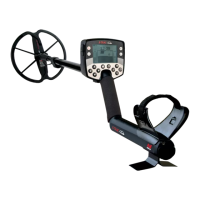
